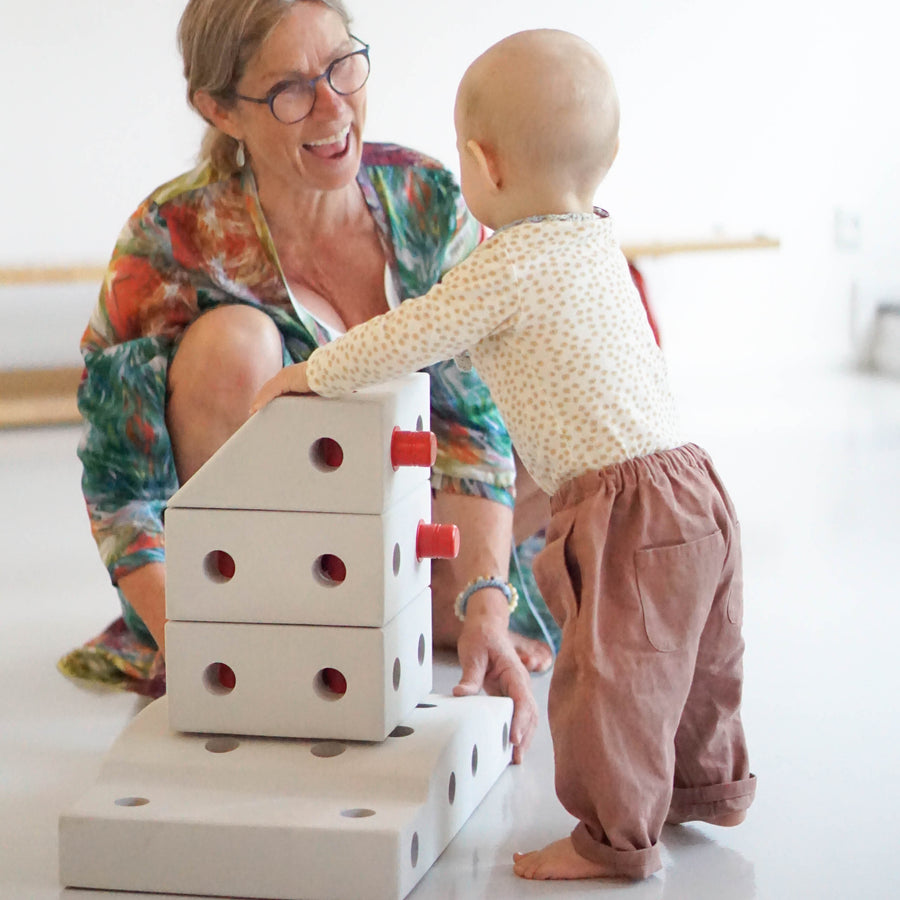Tips from a physiotherapist
As a pediatric physiotherapist, I always look for new, motivating tools and equipment that I can use in my work. The purpose of these tools is to encourage children to move and play and to use their whole body to explore and develop gross motor skills.

What Makes MODU Great for Motor Skill Development
My name is Hannah Harboe and I am the founder of Børnefyssen, a pediatric physiotherapy clinic, based in the center of Copenhagen. I've chosen five basic activities to show how I use MODU in my daily work.
The different elements make MODU useful for children at any age. The toy enables them to play independently, building and exploring, but it also makes room for great interaction and co-play.
The toy can be used for countless activities and exercises. You can make your favorite animal into a ride, create your own obstacle course, do balance exercises or engage yourself in creative play.
Tummy Time
Tummy time is one of the most basic baby activities — and an important one! The exercise strengthens back and neck muscles and helps your baby develop motor skills that will enable them to lift their head and eventually roll over, sit and crawl.
Start off simple by tilting your baby on the base block, or place two pegs at the end to raise your baby slightly from the floor.
In time, you can challenge their motor skills by placing them on a floor board using the base block and the small caster wheels.
In the beginning, it’s good to place a peg on either side of their hips to prevent them from rolling off the board.
Make sure your child is placed on the middle of the board and that their knees and elbows are on the block.
Once they are used to lying on the board, you can remove the supporting pegs and start moving the board around. Start out slowly and increase the speed and change of direction gradually.
Stay engaged with your child during the whole exercise to prevent overstimulation and to make sure that they enjoy the activity.
Standing Up
I also use the blocks as a stabilizer to exercise standing up. The exercise contributes to the developement of balance and stability and it strengthens your child's leg muscles.
Help your child off the floor into a kneeling position. Encourage them to pull themselves up while holding on to the creation. Grab their hips to assist.
It is important to let them decide for themselves how long they keep the standing position. If they start to get fussy or upset, they might need help to lower themselves down.
Generally, this exercise is all about the process — let them stand for a few seconds, lower themselves down and get right back up!
Walking
Once your child has mastered standing up, it’s time for their next move — walking!
In the beginning, most children like to walk sideways while holding on to objects, like a couch, but when they are ready to venture off more independently, walkers are a great form of exercise.
Unlike holding a child’s hands, a walker provides better weight distribution, and the child has more control. The foam wheels are very stable and only move back and forth.
In the beginning, it’s always good to place yourself in front of the walker to make sure that your child can keep up.
Once they’re confident cruising around, you can challenge their balance by holding out objects in front of them to grab.
In time you can also replace the foam wheels with the smaller caster wheels. The caster wheels have the ability to move in all directions and will require more balance and control.
Scooters and Ride-Ons
At the age of 1 ½ - 2 years, most kids are pretty good at walking and they will search for new ways to explore their stability and balancing skills.
Action and speed become an important factor here like going on a swing set or down a slide — anything that involves movement and makes their tummies tickle!
From MODU you can build scooters and rides in all shapes and sizes — a fun, multisensory activity that helps to fine-tune their motor skills.
Riding around strengthens their balance and ability to hold an upright position while kicking with one leg at a time. And it develops their coordination as they are required to steer and keep their eyes on the road at the same time.
These skills will come in handy later on and they will be able to recognize the activity when it’s time for them to learn how to use a balance bike or ride a real bike.
Balance Play
MODU grows with your child and balance play is fun and challenging for kids at any age.
Turn the MODU base block upside down and add a round block underneath to get a nice balance board. Play around either standing, sitting or lying down.
Besides balance, the board is useful for practicing weight transfer, spatial awareness, and coordination.
In the beginning, your child may need some help to get onto the board and a hand to hold onto as they explore the different movements.
In time, you can also swap out the round block with a half ball to make it even more challenging.














